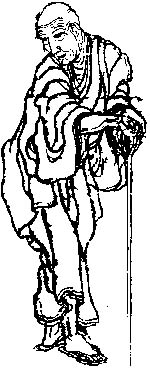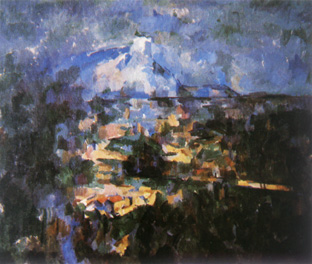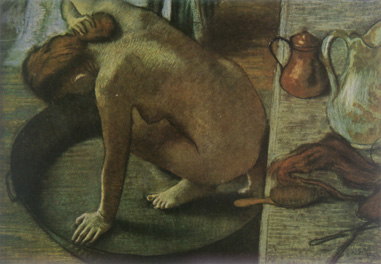During my stay in Macau from late March until April 1993 as a Visiting Artist at the Academy of Visual Arts, I had the unexpected opportunity of viewing the most acclaimed original series of ukiyo-e prints by Hokusai (1760-1849), known as 36 Views of Mount Fuji. These masterpieces include an original thirty six prints, in which the key blocks of the main design lines were printed in blue, and an additional ten prints printed in black known as the 'far side of the mountain' and supposedly produced between 1831 and 1833 in Japan.
 Self-portrait of Hokusai as an old man. Brush sketch, Museum of the Louvre.
Self-portrait of Hokusai as an old man. Brush sketch, Museum of the Louvre.
This set of original prints has recently been acquired by the Macau Government Bank. Unfortunately, I only had a very short time to view them just before the opening of my own exhibition in a gallery in the centre of Macau. Consequently, I did not have as much time to check, examine and appreciate the prints as I would have wished for. Nevertheless, my initial impression was that all the prints looked extremely well preserved with vivid fresh colours as though they had been printed very recently. The papers looked new, without any traces of damaged edges or folded comers, except for traces of fold lines in the centre of the print. It was common practice at the print shops to fold the prints in the middle to make it easier for customers to carry them back home. In most of the prints, the blue parts of the gradations and especially of the sky, and other main lines which were printed with the first key blocks have remained particularly bright and clear.
They could be mistaken, for a reproduction for in fact this series was already very popular in Japan at the time of its publication and many reproductions were made in later centuries. I looked at the prints individually until I came to one of the most famous of all called Gaifu Kaise (Mount Fuji on a Clear Breezy Day), commonly known as 'Red Fuji'. I stopped for a while to check it carefully, because the red colour of the mountain looked rather thin as if the print had been chemically cleaned for conservation. When I checked the blue and other parts, however, the colours looked fresh and strong, the paper's texture was soft enough and at the foot of the mountain, at the bottom edge of the composition, there were two slightly damaged parts which had been caused by the original block. These scars assured me that this was undoubtedly an authentic print. The thin colouring of the red parts can be explained by the fact that this type of colour was probably used in one of the earliest editions of this magnificent work of art.
 One of the scenes from the series Mont Saints-Victoire, by Paul Cézanne (1904-06).
One of the scenes from the series Mont Saints-Victoire, by Paul Cézanne (1904-06).
Thus it immediately sprang to my mind that this series of prints had been taken out of Japan by foreigners after they bought them from Japanese collectors at a fairly early stage.
Ukiyo-e prints were designed to please the general public from the middle of the seventeenth century up to the nineteenth century in Edo, as Tokyo was formerly known. The daily life and amusements of the common people were used as subject matter. Since prints could be purchased for a reasonable price, it became fashionable among the common people to buy and keep them at home in the place of more expensive paintings. Obviously ukiyo-e prints were not considered as important an art form as the paintings of the same period which belonged to accepted schools and were supported and protected by the government. However, the prints were collected later on by many foreigners who already acknowledged their charm and extraordinary beauty. This is why many good impressions of the ukiyo-e prints were so easily transported out of Japan and were well preserved by many non-Japanese connoisseurs of art.
It is worth mentioning at this point that the Tokyo National University of Fine Arts and Music, the only government-supported tertiary level college of art and music in Japan where I lecture has in its own collection only a few ukiyo-e prints. Even the Tokyo National Museum owes its collection of ukiyo-e prints to a generous donation by Mr Kojiro Matsukata, the famed collector of Western art. Mr Matsukata lived in Europe for a long time and became aware of the importance and artistic qualities of the ukiyo-e prints. He later bought a large collection from a French collector and brought them back to their home country.
We are all aware of the fact that ukiyo-e prints first received recognition in Europe by the Impressionist artists. They valued them rightly for their superb artistic value and admired the dynamic composition and detailed depiction of movements of both human figures and the bird's-eye view expressed as though through a camera lens.
They were also amazed by the flat printed colouring which excelled in giving an illusion of volume and depth. French artists such as Monet, Manet, and later on Degas, Lautrec, Van Gogh and Gauguin were all inspired by them in some ways. I feel that we can see some influence in Cezanne's works as well, even though it is common knowledge that Cezanne criticised the Japanese prints for their simple forms and flat colouring. This is somewhat understandable judging from his Cubist way of expressing forms aimed at giving a three-dimensional effect to the two-dimensional canvas. If one examines his famous series of paintings of Mont Sainte-Victoire (1885-87), one comes across some similarities with Hokusai's 36 Views of Mount, primarily due to the fact that it is a series, and secondly because Sainte-Victoire is painted to look much higher than it actually is. These paintings were most probably produced after the style of Hokusai's 36 Views of Mount Fuji. Moreover, the technique of using blue tones for the main lines and forms reminds us of the blue which Hokusai used in most of the prints including the main lines printed by the first key blocks. This blue was called bero-ai at the time, meaning Berlin blue, a blue colour which was first exported from Berlin to Japan by the Dutch East India Company in the early eighteenth century. Berlin's position as capital of the Prussian empire meant that this blue was referred to as Prussian blue in Europe. This bright strong blue colour became very popular after a while and was often used by the ukiyo-e masters. Hokusai was actually one of the first artists to use this blue colour in Japan.
Another interesting thing is the fact that in this series Hokusai used three different names depending on the period when the print was made. When he first published 36 Views of Mount Fuji, he changed his name from Hokusai to Iitsu. However, since the name of Hokusai was so widely known at that period, he continued to use it partly in this series as "Hokusai changed to Iitsu" or "Iitsu the former Hokusai" and sometimes even "Hokusai Iitsu". This may seem rather strange and odd, but as far as can been deduced from the stories and anecdotes told about Hokusai, he appears to have been eccentric and unpredictable in many ways. During his long life he changed his pen name at least thirty times. It may be hard to believe, but he also changed his dwelling place at least ninety times, claiming that it was easier to move than to be bothered with house cleaning chores.
This constant urge in Hokusai to move from one place to another and to change names reflects his desire to explore new methods and techniques or means of expression.
It is therefore highly probable that by changing his names around the time of the creation of this series of 36 Views of Mount Fuji, he intended to tell us that here he was another man, not only in name but also in style.
It seems to me that this series is the result of all that he had accomplished up to that period and it represents one of the greatest achievements of his life-long artistic career.
I am filled with admiration for these prints which are sure to remain forever as great works of art while also feeling a certain envy for the Macau Government Bank for having been able to acquire such an outstanding impression of Hokusai's most celebrated masterpiece. □

La Tube (The Bathtub), pastel by Degas (1886).
* Tetsuya Noda is a printmaker and Professor of Printmaking at the Tokyo National Museum of Fine Arts and Music.
start p. 99
end p.